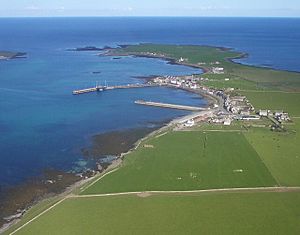Whitehall, Orkney facts for kids
Quick facts for kids Whitehall |
|
|---|---|
 An aerial view of Whitehall Village, with Lower Whitehall and Grice Ness beyond |
|
| OS grid reference | HY656283 |
| Civil parish | |
| Council area | |
| Lieutenancy area | |
| Country | Scotland |
| Sovereign state | United Kingdom |
| Post town | ORKNEY |
| Postcode district | KW17 |
| Dialling code | 01857 |
| Police | Northern |
| Fire | Highlands and Islands |
| Ambulance | Scottish |
| EU Parliament | Scotland |
| UK Parliament |
|
| Scottish Parliament |
|
Whitehall is a small, interesting village located on the island of Stronsay. This island is part of the Orkney Islands in Scotland. It's a cozy place with about 50 houses.
You can find a few useful spots in Whitehall. There's a shop for your needs and a café. You can also visit the Fish Mart, which is a heritage centre. It's a great place to learn about the village's past. The Stronsay Hotel has a pub attached. There's also a post office, a pier for fishing boats, and another pier for ferries.
A Look at Whitehall's History
Whitehall was once a very busy place, almost like a "boom town." This means it grew very quickly and became rich. Its growth and later decline were closely tied to the herring fishing industry. The Dutch people first helped to develop this industry here.
How Whitehall Got Its Name
The village gets its name from a special house. This house was built in the 1670s by a man named Patrick Fea. He was a retired privateer, which was like a sailor who had permission from the government to attack enemy ships. Later, one of his family members, John Fea, started a new business. In 1722, he began the kelp burning industry on the island. Kelp is a type of seaweed, and burning it helped create useful products.
The Rise and Fall of Herring Fishing
Whitehall was once the biggest herring port in the northern Orkney Islands. It traded a lot with ports around the Baltic Sea. At its busiest time, about 300 fishing boats were in Whitehall harbour. There were also fifteen "curing stations." These were places where fish were prepared and preserved. About 1500 "fish wives" worked here, helping to process the fish.
Many people who lived here during the busy season were "itinerant." This means they moved around for work. The village was very lively back then. The large, impressive houses you can still see today show how wealthy the town became.
The herring industry started to decline for a few reasons. One big reason was "overfishing," meaning too many fish were caught. This made it harder for fish populations to recover. The outbreak of World War I also caused a decline. There was a short period of recovery between the two World Wars. However, the industry faced another big decline with the start of World War II.


